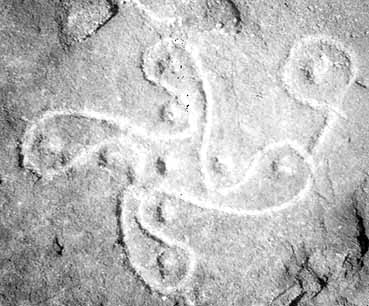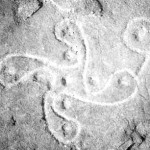TRACCE no. 10 – by Gyrus
The Swastika Stone near Ilkley in West Yorkshire (England).
I would like to present some findings and ideas in relation to the so-called Swastika Stone, located on the moors near Ilkley in West Yorkshire, England.
The stone overlooks the valley of the River Wharfe, and is identical to some of the ‘Camunnian Rose‘ designs in Val Camonica, Italy – nine cup-marks in a cross shape, surrounded by a curved swastika-shaped groove. The Ilkley carving also has an ‘appendage’ off the east arm – a cup surrounded by a curved hook-shaped groove. It is unique on the moor (which is covered in hundreds of cup-and-ring type carvings) although there is an unfinished swastika design (more angular, without cups) on the nearby Badger Stone. My prime concern is with interpretation of the design.

The so-called Swastika Stone, located on the moors near Ilkley in West Yorkshire, England decorated with swastikas and other solar motifs
One of the lines of cups on the Swastika Stone is less than a degree off magnetic north-south. (1) One naturally looks north from the stone, as it is on a rocky outcrop on the north side of the moor. Was it associated with the Pole Star with which its cups align? Why then does its shape describe a clockwise motion, whereas the stars turn anti-clockwise around the pole?
Perhaps the design relates to the shamanic practice of ascent up the ‘Pillar of the World’ (to use the Lapp term). Numerous Siberian and northern European peoples documented by Mircea Eliade (2) see the Pole Star as the summit of a pole holding up the sky (seen as a tent). Eliade notes similar beliefs about the Pole Star in Ancient Saxon, Scandinavian and Romanian myths. If, then, one imagines the Swastika design to be the base of a Pillar of the World, the implicit motion of the design makes sense. Something that appears to turn anti-clockwise when looking up from the bottom of a pole will, if it slides down the pole and is viewed from above, appear to turn clockwise.
The Swastika may map the turning sky down onto the ground, forming the bond between 'levels' that is so central to shamanic cosmology.
Also, the ‘appendage’ cup, in relation to the central cup, would have only been a couple of degrees off the summer solstice sunrise during the period 2000BCE – 100CE (covering most of the likely times at which the glyph was carved. The ‘hook’ groove, if imagined to turn with the swastika, would ‘haul’ the cup-sun across the sky. This seems to strengthen the swastika-sky connection.
(I should note that I do not support the idea that cup-and-ring patterns are maps of stellar constellations. Perhaps some involved rudimentary attempts at this, but no one has found accurate correspondences in any existing patterns. They seem to me to be more generally concerned with access points to alternate realities).
With the Pole Star/Pillar of the World ideas in mind, one could see some cup-and-ring markings as being related. The ‘tail’ grooves could be the Pillar reaching up to the cup-pole, surrounded by rings of revolving stars. Some local cup-and-ring markings, like those on the Panorama Stone, have ‘ladders’ instead of ‘tail’ grooves. This image further supports the shamanic interpretation of the petroglyphs, as ladders are among the most frequently occurring representations of shamanic ascent to other worlds. Human figures atop ladders appear in !Kung San rock art related to trance-state ascension.
Cup-and-ring style petroglyphs in the British Isles are usually dated to the Bronze Age (because some are included in, or in the proximity of, Bronze Age burials) or the Neolithic (because of comparable carvings on Irish passage graves from that period – see also Richard Bradley’s recent work ‘Signing the Land’ for arguments dating this style of prehistoric art to the Neolithic).
The Swastika Stone is arguably associated with this style of rock art, due to its use of cup-marks, but I have recently come to see it as most likely originating in the Iron Age, or even during Roman occupation. This is because of Verbeia, a Romano-Celtic goddess revered by the Roman troops stationed in Ilkley (then Olicana). Verbeia is often accepted as being a version of the Celtic spring/fire goddess Brigid, who is still associated with swastika-like symbols in Ireland. Also, the Roman cohort which set up her altar were recruited from the Lingones, a Gaulish Celtic tribe. Apparently Romano-Celtic coins have been found in Gaul bearing swastika-like designs. It seems tempting to think that the Lingones cohort carved the Swastika Stone when they were here, but this would surely be unusual. Or perhaps the recruited Celtic/Roman troops were influenced in their choice of ‘genuis loci’, Verbeia, by the native Celts of West Yorkshire, the Brigantes (whose name derives from the goddess Brigantia, related to Brigid), who may have already carved the stone.
For a more detailed analysis of the Swastika Stone, Verbeia, and the pre-Christian pagan history of the Wharfedlae region in West Yorkshire, see ‘VERBEIA: Goddess of Wharfedale‘, an A5, 32-page booklet devoted to these subjects.
Send £2.50 (sterling cheques to ‘Rooted Media’) or 8 International Reply Coupons to:
Rooted Media, The Cardigan Centre, 145-149 Cardigan Road, Leeds, LS6 1LJ, England
- BENNET, Paul, Circles, Standing Stones and Legendary Rocks of West Yorkshire (Heart of Albion Press, 1997), p. 53.
- ELIADE, Mircea, Shamanism: Archaic Techniques of Ecstasy (Arkana, 1989), pp. 260-262.
back to index TRACCE no. 
![]()
![]()















[…] One of the lines of cups on the Swastika Stone is less than a degree off magnetic north-south. One naturally looks north from the stone, as it is on a rocky outcrop on the north side of the moor. Was it associated with the Pole Star with which its cups align? Why then does its shape describe a clockwise motion, whereas the stars turn anti-clockwise around the pole? http://www.rupestre.net/tracce/?p=1777 […]